
We filled up a Peggy 2 with 2×2 super-pixels consisting of red, green, blue, and white 10 mm LEDs. This makes an easy and big programmable full-color LED matrix.
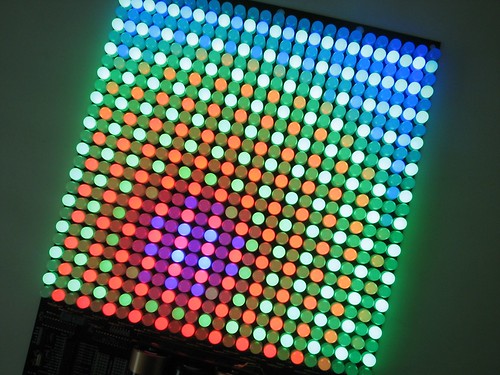
Peggy fits 25×25 LEDs, so if you fill every hole this way, you wind up with a 12.5 x 12.5 pixel RGBW matrix.
And like whoa— you can animate it.
Yup, there’s video. The video is embedded below, and you can also view it directly at YouTube. (In either case, please excuse the scanline artifacts produced by our camera.)
One thing worth noting (and that we demo in the video) is that you can diffuse the big RGBW pixels into one continuous full-color display by placing a thin diffusing plastic layer above the LEDs– it really works well.
The demo code is an Arduino sketch, based on Jay Clegg’s timer-interrupt style grayscale driver for Peggy (demonstrated here), you can download it here (12 kB Arduino .pde sketch file). Besides the colorful flow shown in the pictures, this code also has a mode to light just the red, green, blue or white LEDs at a time.




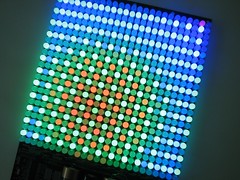
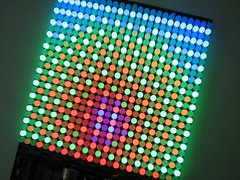
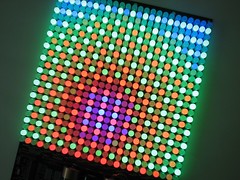
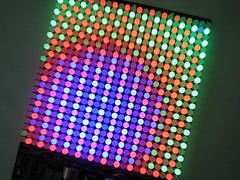
Yay, a sine plasma, like my coffee table ([link:]http://www.flickr.com/photos/macetech/3483946654/)!. Well, I mean a square root plasma, you guys didn’t bother doing a sine on the distance from center. Neat way of getting RGBW out of the Peggy!
Neat– that looks pretty good; I hadn’t considered using a sine wave, but yours does look cool. I guess that you could possibly describe ours a three-phase triangle wave. For us, there would be a visual problem in that circular functions spend a lot of time near the extrema– we’ve only got four bits of intensity per color with this program, so it really makes more sense for us to vary the brightnesses linearly. But you’ve got 10 bits per color– that’s quite a difference!
—
Windell H. Oskay
drwho(at)evilmadscientist.com
http://www.evilmadscientist.com/
Oh man. That’s intensely awesome.
Mine is coming slowly. We’re moving house this month, so project work is kind of on hold at the moment. But I did get free access to a laser cutter… 8)
Neat!
How hard do you think it would be to control the leds through a electronic drums midi – comp setup?
That should be pretty straightforward (and pretty kick-ass) as a DIY project. I’d suggest doing it by using an external Arduino– with appropriate MIDI-in hardware –to feed data to the Peggy over TWI (aka I2C). So, essentially you could do it by combining this project and this project.
—
Windell H. Oskay
drwho(at)evilmadscientist.com
http://www.evilmadscientist.com/
Looks easier than i imagined, if we ever work it out and do a show with it you ll be the first to know. :) Thx!
Way Awesome. Neat trick with the plastic diffuser. Can’t wait to put my Peggy2 together ^_^
First off I just wanted to say this looks amazing. I have seen peggy linked all over the place but didn’t really pay much attention to it until now. I didn’t realize how versatile it could be.
I have been wanting to make a fully programmable disco floor for a while now but all of the options I have looked into are way too expensive. Just the electronics for it would cost at least $600 and that is a little steep for me.
I’m thinking with peggy I can have wires leading from the main board to 4 LED’s in separate 6"x6" squares that together make a 12×12 grid similar to peggy just increased in size. I will then cover the entire floor with opaque plexiglass.
The one thing I am worried about is whether the 4 LED’s in each 6"x6" square will be bright enough and if not is there a solution?
Also any other suggestions would be great!
Amazing. With the diffuser, it’s close to Acidwarp without the computer. No where close to building one (more of a coder then a builder) but plenty to think about there. I wonder if the led density, low as it is, couldn’t be narrowed further by non-square placements, further diffusion and slower fades. Could be the next surface-mount LED kids toy at McDs..
i love this :)
is the diffuser a common part, or standard type of material?
This is just a scrap of milky-white acrylic that we had lying around; many types of plastic work well as diffusers.
—
Windell H. Oskay
drwho(at)evilmadscientist.com
http://www.evilmadscientist.com/
where can someone get the 10mm LED’s that are used?
This particular bundle of LEDs is the RGBW set available at the Evil Mad Science Shop.
—
Windell H. Oskay
drwho(at)evilmadscientist.com
http://www.evilmadscientist.com/
don’t forget about artist Jim Campbell- his work has dealt with these exact tools for years! http://www.jimcampbell.tv/
this is really cool, im afraid im a complete noob at all this, but i really want to get into it, is there a smaller version of that board i could use with regular sized LED’s? also do you have a link to a tutorial on how to make one?
thanks :)
Regular size LEDs *are* compatible with the Peggy 2.
—
Windell H. Oskay
drwho(at)evilmadscientist.com
http://www.evilmadscientist.com/
yeh sorry i misheard something at the start of the video, is there a tutorial on how to build one of these?
There’s a whole lot of information about this project, including schematics and build instructions. You might start here.
—
Windell H. Oskay
drwho(at)evilmadscientist.com
http://www.evilmadscientist.com/
oops, misheard at the start theyre regular size LED’s :S
nevermind hehe
Hey, Windell.
I’ve been trying to find some of this milky-white acrylic; no joy. Please advise.
Sincerely,
FeeTheGrid
You might try contacting your local plastics shops directly. However, even a regular sheet of white paper works pretty well for this application– all that you really need is a diffusing screen of some sort. Also, if you have a sheet of clear plastic, try sanding it heavily on both sides to make a good diffuser.
—
Windell H. Oskay
drwho(at)evilmadscientist.com
http://www.evilmadscientist.com/
Agreed.
I am currently working on a project which will use the peggy 2.0 schematic to achieve outcomes similar to his wave modulation project. Using motorized acyrlic panels which will move closer to the leds to display pixels and further away, more suitable for monochrome video. I am using this project as a starting point also, especially in terms of size.
http://www.flickr.com/photos/mrbon/tags/leds/
I am in the process of putting this proposal together to ask some questions.
the LEDs sold by EMS have different voltages for the different colors:
– red 25mA x 1.9 V
– green 30mA x 3.8 V
– blue 30mA x 2.7 V
– white 30mA x 2.7 V
From the schematics it’s not obvious how you set the forward voltage for the LEDs and how you would do it if you need different ones for the individual colors.
can you explain how you did it? or did i miss something here? thanks.
The Peggy 2 uses constant-current LED driver chips, which deliver the same current to all of the lit LEDs, even though they have different forward voltages. In other words, the chips automatically change their output voltage as needed to provide the same current to each LED.
—
Windell H. Oskay
drwho(at)evilmadscientist.com
http://www.evilmadscientist.com/
This is great. Would it be possible to load a loop of video onto the peggy2, or is an attached computer / serial communication required?
A *short* loop of video can be loaded on– so long as it fits in the program memory.
Windell H. Oskay
drwho(at)evilmadscientist.com
http://www.evilmadscientist.com/